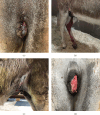Partial Phallectomy and Penile Retroversion as a Surgical Approach for Severe Preputial Laceration in a Donkey (Equus asinus)
- PMID: 40697770
- PMCID: PMC12283187
- DOI: 10.1155/crve/9036471
Partial Phallectomy and Penile Retroversion as a Surgical Approach for Severe Preputial Laceration in a Donkey (Equus asinus)
Abstract
Penile trauma in equines can cause injuries of varying severity, potentially leading to temporary or permanent dysfunction. In severe cases, various surgical techniques can be employed to restore the animal's quality of life, such as partial phallectomy combined with penile retroversion. However, descriptions of the application of this technique in donkeys are lacking. This report describes the surgical treatment of a donkey with extensive preputial and penile laceration using the technique of partial phallectomy combined with penile retroversion. An 18-month-old intact male donkey presented with extensive preputial and penile lacerations, resulting in the complete rupture of the preputial lamina, permanent penile protrusion, tissue necrosis, and urethral rupture with urine leakage. The donkey underwent a partial phallectomy and penile retroversion after a 2-week preoperative period, which included debridement, dressings, and antibiotic therapy. The surgical procedure involved the creation of a perineal urethrostomy and partial penile amputation. Postoperative care included antibiotic and anti-inflammatory therapy, as well as local wound management. Postoperative complications included postmicturition hemorrhage and partial suture dehiscence. Despite these issues, a complete recovery was achieved, and the donkey was discharged after 56 days postsurgery. Four years later, the donkey was urinating normally without complications. Penile retroversion combined with partial phallectomy proves to be an effective surgical approach for treating extensive penile and preputial lacerations in donkeys, providing lasting results and long-term complication-free outcomes.
Copyright © 2025 Letícia Paranhos Rios Andrade et al. Case Reports in Veterinary Medicine published by John Wiley & Sons Ltd.
Conflict of interest statement
The authors declare no conflicts of interest.
Figures




References
-
- Schumacher J. Penis and Prepuce. In: Auer J. A., Stick J. A., Kümmerle J. M., Prange T., editors. Equine Surgery . 5th. W.B. Saunders; 2019. pp. 1034–1064. - DOI
-
- Gaughan E. M., van Harreveld P. D. Trauma to the Penis. In: Samper J. C., Pycock J. F., McKinnon A. O., editors. Current Therapy in Equine Reproduction . W.B. Saunders; 2007. pp. 227–230. - DOI
-
- Straticò P., Varasano V., Celani G., Suriano R., Petrizzi L. Long-Term Outcome of En Bloc Extensive Resection of the Penis and Prepuce Associated with a Permanent Perineal Urethrostomy in a Gelding Affected by Squamous Cell Carcinoma. Case Reports in Veterinary Medicine . 2016;2016:5. doi: 10.1155/2016/6989450.6989450 - DOI - PMC - PubMed
-
- Archer D. C., Edwards G. B. En Bloc Resection of the Penis in Five Geldings. Equine Veterinary Education . 2004;16(1):12–19. doi: 10.1111/J.2042-3292.2004.TB00261.X. - DOI
Publication types
LinkOut - more resources
Full Text Sources
